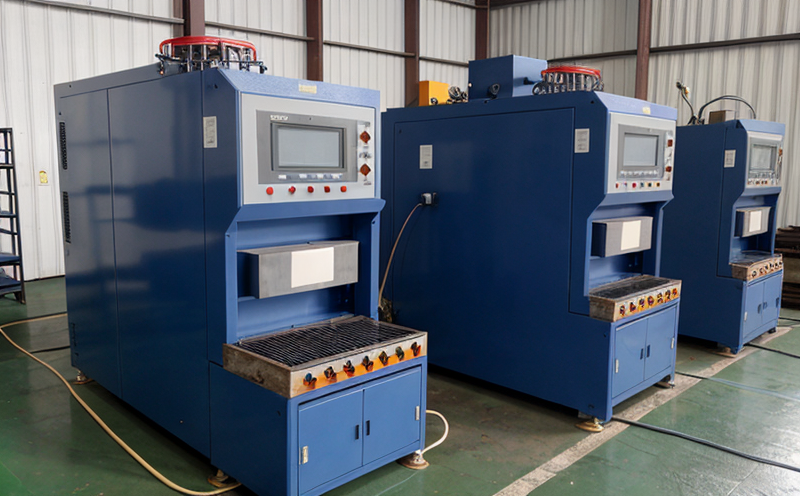ASTM D4291 Trace Elements in Coal Ash Testing
The ASTM D4291 standard specifies a method for determining trace elements in coal fly ash. This testing is crucial for understanding the composition of coal ash, which is an important byproduct of coal combustion processes used in industrial manufacturing and processing. Coal ash contains various trace elements that can have significant impacts on environmental regulations, product quality, and health considerations.
Trace elements such as arsenic (As), chromium (Cr), lead (Pb), mercury (Hg), selenium (Se), vanadium (V), and others are evaluated through this test. These elements may be present naturally in coal or introduced during the combustion process due to varying fuel sources or additives used by power plants and industrial facilities.
The ASTM D4291 method employs inductively coupled plasma optical emission spectrometry (ICPOES) for quantification of these trace elements. This technique allows for accurate detection down to parts per million levels, making it suitable for identifying even minute amounts of contaminants that could affect downstream processes or final products.
Proper sample preparation is critical in achieving reliable results. Typically, coal fly ash samples are dried and ground into fine powders prior to analysis. This ensures homogeneity within the sample batch being tested, which minimizes variability introduced during measurement. Additionally, appropriate digestion procedures may need to be applied depending on the specific matrix of the coal ash.
Once prepared, the samples undergo dilution steps followed by introduction into the ICPOES instrument where they are atomized and excited to emit characteristic wavelengths corresponding to each element present in the sample. The intensity of these emissions is measured and compared against calibration standards to determine concentrations accurately.
The results from this test serve multiple purposes including compliance with environmental regulations, ensuring raw material quality for further processing steps, assessing potential health risks associated with handling or disposing of coal fly ash waste materials, and optimizing fuel blends used in power generation plants based on elemental content.
Compliance with international standards like ASTM D4291 is essential for industries operating globally as it sets a benchmark against which performance can be measured uniformly across different regions. By adhering to these guidelines, manufacturers ensure consistency in their products while also demonstrating responsible practices towards resource management and waste disposal.
Benefits
The ASTM D4291 trace elements analysis provides several key benefits for industrial manufacturing and processing facilities:
- Regulatory Compliance: Ensures adherence to environmental laws regarding hazardous substances in coal fly ash.
- Quality Assurance: Helps maintain consistent product quality by monitoring the elemental composition of raw materials used in manufacturing processes.
- Risk Management: Identifies potential health hazards linked to exposure to certain trace elements during production or disposal operations.
- Informed Decision Making: Provides data necessary for optimizing fuel blends and improving efficiency within power generation facilities.
By leveraging the insights gained from ASTM D4291 testing, companies can enhance their operational processes, mitigate risks associated with non-compliance, and contribute positively to sustainability initiatives aimed at reducing environmental impact.
International Acceptance and Recognition
The ASTM D4291 standard enjoys widespread acceptance among industrial manufacturers and processors worldwide. Its rigorous methodology aligns closely with global regulatory frameworks governing coal ash management, thereby ensuring that the results obtained are universally recognized and accepted.
In countries adhering to European Union directives such as EU Waste Framework Directive (WFD) or ISO standards, laboratories performing ASTM D4291 tests will find their findings readily applicable without requiring additional conversions. Similarly, in North American markets where Canadian Environmental Protection Act (CEPA) and US EPA regulations apply, compliance with ASTM D4291 ensures seamless integration into regulatory requirements.
The international nature of this standard makes it particularly useful for multinational corporations involved in cross-border operations or those participating in global supply chains. It facilitates collaboration between stakeholders across different geographical regions by providing a common language for communication about coal ash characteristics and associated risks.
Use Cases and Application Examples
| Use Case | Description |
|---|---|
| Environmental Monitoring | Monitoring trace element concentrations in coal fly ash for compliance with local environmental regulations. |
| Raw Material Screening | Evaluating incoming coal supplies to ensure they meet specified limits on harmful elements before processing. |
| Product Development | Optimizing fuel blends and developing new formulations by understanding the elemental composition of raw materials. |
| Waste Management | Assessing the suitability of coal fly ash for reuse or disposal based on its trace element profile. |
- Power Generation: Utility companies rely on ASTM D4291 to monitor emissions from power plants, ensuring they meet emission limits set by environmental authorities.
- Mining Operations: Coal miners use this test to assess the quality of coal being extracted and its potential impact on downstream processes.
- Sustainable Development: Organizations committed to sustainable practices integrate ASTM D4291 testing into their supply chain management strategies, focusing on reducing contamination levels in coal ash.
These examples illustrate how ASTM D4291 trace elements analysis plays a vital role in various aspects of industrial manufacturing and processing. From ensuring regulatory compliance to enhancing product quality, this method contributes significantly towards creating safer work environments and more sustainable practices across different sectors.





